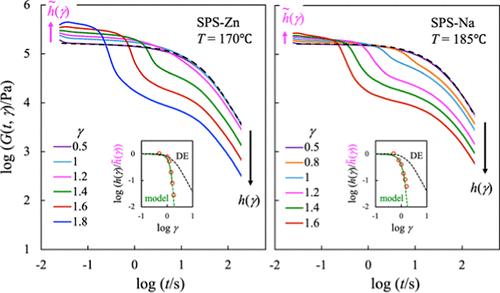非纠缠缔合聚合物的非线性松弛:应变诱发硬化和软化
IF 5.2
1区 化学
Q1 POLYMER SCIENCE
引用次数: 0
摘要
研究了以锌(Zn)或钠(Na)为反阳离子的磺化聚苯乙烯(SPS)两类离聚物在阶跃应变γ下的非线性应力弛豫。这些SPS样品分子量低(Mw = 11 kg mol-1),并且本身处于未纠缠状态,但平均每条链上有两个相关的盐基团(贴纸),从而形成一个由这些贴纸的聚集体维持的瞬态网络。黏贴与聚集体的热解离比黏贴之间链主链的劳斯运动要慢得多,因为黏贴脱离聚集体需要很大的能量。因此,对于SPS-Zn和SPS-Na离子单体,终端弛豫要比本征劳斯弛豫慢得多。对于线性粘弹性状态下的小γ(=0.5),这种末端弛豫几乎是单麦克斯韦式的,可能是因为离聚体骨架只有两个黏贴(平均),而一个黏贴的解离使整个骨架松弛。对于较大的γ(仍低于2),SPS-Zn和SPS-Na离子单体在短时间t表现出应变硬化,随后在长时间t表现出快速模量衰减和末端松弛区应变软化。在末端松弛区,非线性松弛模量G(t,γ)服从时间-应变可分性,G(t,γ) = G(t)h(γ),其中G(t)和h(γ)分别为线性松弛模量和阻尼函数。讨论了这些非线性特征与应变引起的联想网络结构变化的关系。短t处的硬化不是由有限可扩展非线性弹性(FENE)引起的,因为黏贴之间的链骨干太长,在γ <处表现出明显的FENE效应;2. 相反,硬化与应变诱导的黏贴聚集增强有关,而不是在施加应变之前参与大而稳定的聚集体。相应的,硬化后的快速应力衰减归因于黏贴形成的聚集体的机械断裂。在这种破裂之后,残存的聚集体维持的瞬态网络将通过这些聚集体的热解离而松弛。这个热过程应该与平衡时的过程非常相似,这导致了长t时G(t,γ)的时间-应变可分性。这些非线性的结构参数与双步反应变试验以及假设聚集体机械断裂和连续平衡的模型分析相一致。本文章由计算机程序翻译,如有差异,请以英文原文为准。

Nonlinear Relaxation of Unentangled Associative Polymers: Strain-Induced Hardening and Softening
Nonlinear stress relaxation under step strain γ was examined for two types of ionomers, sulfonated polystyrene (SPS) having either zinc (Zn) or sodium (Na) as the counter-cation. These SPS samples were of low molecular weight (Mw = 11 kg mol–1) and in the unentangled state by themselves but had, on average, two associating salt groups (stickers) per chain thereby forming a transient network sustained by aggregates of those stickers. The thermal dissociation of the stickers from those aggregates was much slower than the intrinsic Rouse motion of the chain backbone between the stickers because of a large energy required for the stickers to escape from their aggregates. Thus, for both SPS-Zn and SPS-Na ionomers, the terminal relaxation was much slower than the intrinsic Rouse relaxation. For small γ (=0.5) in the linear viscoelastic regime, this terminal relaxation was almost single-Maxwellian, possibly because the ionomer backbone had only two stickers (on average) and the dissociation of one sticker allowed the whole backbone to relax. For large γ (still below 2), both SPS-Zn and SPS-Na ionomers exhibited strain-hardening at short times t followed by a fast modulus decay and the strain-softening in the terminal relaxation zone at long t. In this terminal relaxation zone, the nonlinear relaxation modulus G(t,γ) was found to obey the time-strain separability, G(t,γ) = G(t)h(γ) with G(t) and h(γ) being the linear relaxation modulus and the damping function, respectively. These nonlinear features were discussed in relation to strain-induced changes in the associative network structure. The hardening at short t was not attributable to the finite extensible nonlinear elasticity (FENE), because the chain backbone between the stickers was too long to exhibit a significant FENE effect at γ < 2. Instead, the hardening was related to strain-induced enhancement of aggregation of the stickers not involved in large and stable aggregates before imposition of the strain. Correspondingly, the fast stress decay after the hardening was attributed to mechanical rupture of the aggregates formed by those stickers. After this rupture, the transient network sustained by the surviving aggregates would have relaxed through the thermal dissociation of those aggregates. This thermal process should have been very similar to that at equilibrium, which resulted in the time-strain separability of G(t,γ) at long t. These structural arguments of the nonlinearities were in harmony with a double-step reverse strain test as well as a model analysis assuming the mechanical rupture and successive equilibration of the aggregates.
求助全文
通过发布文献求助,成功后即可免费获取论文全文。
去求助
来源期刊

Macromolecules
工程技术-高分子科学
CiteScore
9.30
自引率
16.40%
发文量
942
审稿时长
2 months
期刊介绍:
Macromolecules publishes original, fundamental, and impactful research on all aspects of polymer science. Topics of interest include synthesis (e.g., controlled polymerizations, polymerization catalysis, post polymerization modification, new monomer structures and polymer architectures, and polymerization mechanisms/kinetics analysis); phase behavior, thermodynamics, dynamic, and ordering/disordering phenomena (e.g., self-assembly, gelation, crystallization, solution/melt/solid-state characteristics); structure and properties (e.g., mechanical and rheological properties, surface/interfacial characteristics, electronic and transport properties); new state of the art characterization (e.g., spectroscopy, scattering, microscopy, rheology), simulation (e.g., Monte Carlo, molecular dynamics, multi-scale/coarse-grained modeling), and theoretical methods. Renewable/sustainable polymers, polymer networks, responsive polymers, electro-, magneto- and opto-active macromolecules, inorganic polymers, charge-transporting polymers (ion-containing, semiconducting, and conducting), nanostructured polymers, and polymer composites are also of interest. Typical papers published in Macromolecules showcase important and innovative concepts, experimental methods/observations, and theoretical/computational approaches that demonstrate a fundamental advance in the understanding of polymers.
 求助内容:
求助内容: 应助结果提醒方式:
应助结果提醒方式:


